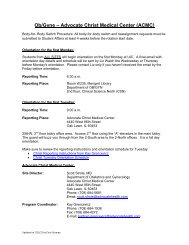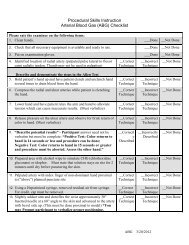a national survey of ASOPRS members. Ophthal Plast Reconstr
a national survey of ASOPRS members. Ophthal Plast Reconstr
a national survey of ASOPRS members. Ophthal Plast Reconstr
You also want an ePaper? Increase the reach of your titles
YUMPU automatically turns print PDFs into web optimized ePapers that Google loves.
V. K. Aakalu and P. Setabutr <strong>Ophthal</strong> <strong>Plast</strong> <strong>Reconstr</strong> Surg, Vol. 0, No. 0, 2011<br />
TABLE 1. Preoperative testing preferences<br />
Question Response choice (No.) % <strong>of</strong> total respondents<br />
When completing<br />
preoperative<br />
evaluations for<br />
ptosis do you<br />
perform a<br />
phenylephrine<br />
test?<br />
If you perform a<br />
phenylephrine<br />
test what<br />
percentage <strong>of</strong><br />
phenylephrine<br />
do you use?<br />
When completing<br />
preoperative<br />
evaluations for<br />
ptosis do you<br />
perform<br />
preoperative<br />
photography?<br />
If you perform<br />
preoperative<br />
photography,<br />
what do you<br />
photograph<br />
(check all that<br />
apply)?<br />
Do you perform<br />
preoperative<br />
visual field<br />
testing?<br />
If you perform<br />
preoperative<br />
visual field<br />
testing what<br />
type <strong>of</strong> testing<br />
do you<br />
perform<br />
(check all that<br />
apply)?<br />
Yes<br />
(n 124)<br />
59.9%<br />
2.5%<br />
(n 109)<br />
61.6%<br />
Yes<br />
(n 202)<br />
97.6%<br />
internal levator aponeurosis advancement surgery did so on patients<br />
with moderate (2–4 mm) ptosis, and 32.4% <strong>of</strong> respondents that<br />
performed internal levator aponeurosis advancement surgery did so<br />
on patients with severe (4 mm) ptosis. Of respondents that<br />
performed concurrent blepharoplasty and ptosis repair procedures,<br />
68% preferred external levator approaches for ptosis repair, while<br />
24.5% preferred internal levator repair procedures.<br />
The frontalis sling procedure preferences <strong>of</strong> respondent<br />
<strong>ASOPRS</strong> <strong>members</strong> are shown in Table 3. Most (93.3%) <strong>of</strong> the respondents<br />
performed frontalis sling ptosis repairs. With regard to materials<br />
2<br />
Full face<br />
(n 144)<br />
69.9%<br />
Yes<br />
(n 180)<br />
87.4%<br />
Confrontation<br />
testing<br />
only<br />
(n 16)<br />
8.1%<br />
Total<br />
respondents<br />
(No.)<br />
No<br />
(n 83)<br />
40.1%<br />
NA NA NA NA NA 207 NA<br />
10% Do not<br />
(n 23) perform<br />
13.0% (n 45)<br />
25.4%<br />
No (n 5)<br />
2.4%<br />
Pr<strong>of</strong>ile<br />
(n 70)<br />
34.0%<br />
No<br />
(n 26)<br />
12.6%<br />
Tangent<br />
screen<br />
testing<br />
(n 34)<br />
17.2%<br />
NA NA NA NA 177 NA<br />
NA NA NA NA NA 207 NA<br />
Eyelids only<br />
(n 154)<br />
74.8%<br />
Don’t perform Other<br />
photography (n 12)<br />
(n 4)<br />
1.9%<br />
5.8%<br />
“Other”<br />
answers<br />
(No. if >1)<br />
NA NA 206 Up- and downgaze<br />
(n 6);<br />
downgaze<br />
(n 5); lateral/<br />
oblique views/<br />
45° angle<br />
(n 10); fullface<br />
up- and<br />
downgaze; upper<br />
50% <strong>of</strong> face -<br />
“full eye plastic<br />
series- 7 views”;<br />
each eye<br />
individually;<br />
each eye<br />
obliquely; eyes<br />
closed; lid skin<br />
held up<br />
NA NA NA NA NA (n 206) NA<br />
Goldmann<br />
kinetic<br />
perimetry<br />
(n 58)<br />
29.3%<br />
Humphrey-<br />
Superior 64<br />
program;<br />
static<br />
perimetry<br />
(n 64)<br />
32.3%)<br />
Humphrey- Other<br />
other (n 12)<br />
program; 6.1%<br />
static<br />
perimetry<br />
(n 44)<br />
22.2%<br />
Do not<br />
perform<br />
visual<br />
field<br />
testing<br />
(n 16)<br />
8.1%<br />
(n 198) NA<br />
NA, not applicable.<br />
The total number in each column may not add to the total number <strong>of</strong> respondents, as respondents were allowed to choose more than one answer for each question.<br />
used during frontalis sling surgery, 74.3% <strong>of</strong> respondents had used<br />
silicone rod material, 34.9% had used autogenous fascia lata, 25.1%<br />
had used cadaveric fascia lata, and 13.3% had used supra-mid material.<br />
A variety <strong>of</strong> other surgical materials were used, and these are noted in<br />
Table 3. In addition, Table 3 separates the surgeon’s preferred use <strong>of</strong><br />
different sling materials by surgeon activity level over the past year.<br />
The dry eye testing preferences <strong>of</strong> respondent <strong>ASOPRS</strong> <strong>members</strong><br />
are noted in Table 4. Of respondents, 47.6% performed preoperative<br />
Schirmer testing, with 43.4% <strong>of</strong> respondents that performed<br />
preoperative Schirmer testing utilizing it on all patients; 84.5% <strong>of</strong> those<br />
© 2011 The American Society <strong>of</strong> <strong>Ophthal</strong>mic <strong>Plast</strong>ic and <strong>Reconstr</strong>uctive Surgery, Inc.



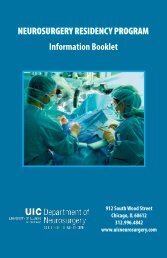
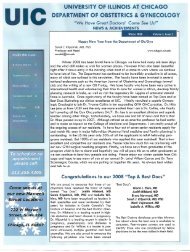
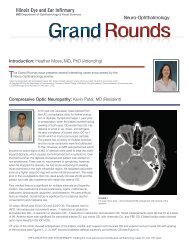
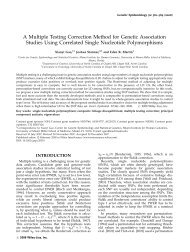
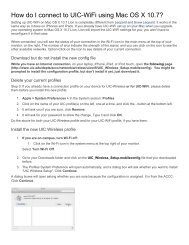
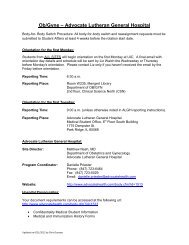
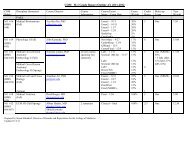

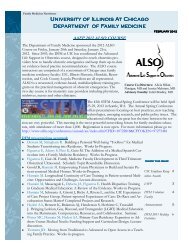
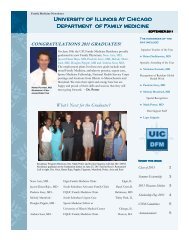
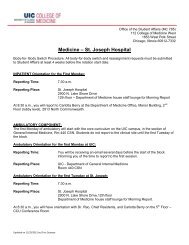
![CV Joan [W51] - University of Illinois College of Medicine at Chicago ...](https://img.yumpu.com/17336863/1/190x245/cv-joan-w51-university-of-illinois-college-of-medicine-at-chicago-.jpg?quality=85)
